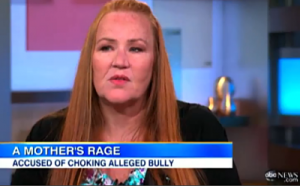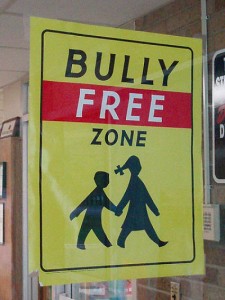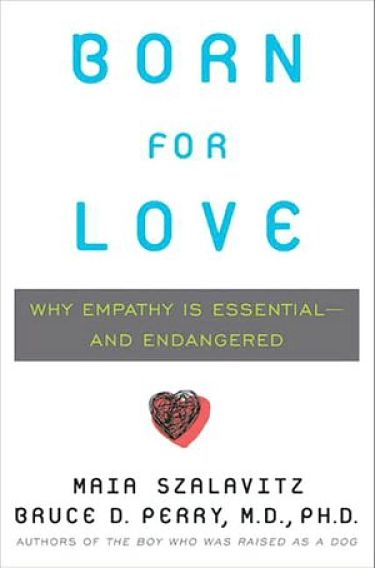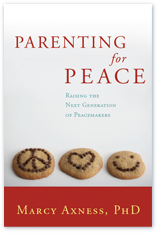 This morning on The View they shared the story of a mother who was arrested for throttling a boy who had allegedly texted unspeakably awful things to her daughter (including — and I’m surely not getting this exactly correct, so pardon my paraphrase — “you’re so ugly I wouldn’t even rape you”). Evidently his tirade of abusive texts had been going on for some time, and the daughter had made anguished comments to her mother that hinted at possible self-harm. When Mom and daughter happened to see this boy at the mall one day…and evidently with sangfroid he reported he was not going to stop the cyber-bullying…well, if you’re a mother, you can probably imagine how she felt as she ended up with her hands around his neck.
This morning on The View they shared the story of a mother who was arrested for throttling a boy who had allegedly texted unspeakably awful things to her daughter (including — and I’m surely not getting this exactly correct, so pardon my paraphrase — “you’re so ugly I wouldn’t even rape you”). Evidently his tirade of abusive texts had been going on for some time, and the daughter had made anguished comments to her mother that hinted at possible self-harm. When Mom and daughter happened to see this boy at the mall one day…and evidently with sangfroid he reported he was not going to stop the cyber-bullying…well, if you’re a mother, you can probably imagine how she felt as she ended up with her hands around his neck.
That very ability, to imagine it — the feelings of a mother whose child is being mercilessly bullied and whose repeated attempts to get their school’s attention and help, to no avail — that is empathy: the ability to imagine what another is feeling, and to care about it. (And the ability to moderate those feelings before they translate into actions is a function of the social brain, which is what my book Parenting for Peace is really all about. The mother has expressed regret at her own violent behavior.)
 In cases like these, there’s always a lot of accusation flying around — particularly of the school system’s ineffectual role in addressing the very serious bullying problem. As I’ve written about in a prior post about the origins of empathy, my opinion (in agreement with many others) is that even the very best school-based anti-bullying or conflict resolution program puts the change lever in the wrong place — that is, way too far down a child’s developmental timeline:
In cases like these, there’s always a lot of accusation flying around — particularly of the school system’s ineffectual role in addressing the very serious bullying problem. As I’ve written about in a prior post about the origins of empathy, my opinion (in agreement with many others) is that even the very best school-based anti-bullying or conflict resolution program puts the change lever in the wrong place — that is, way too far down a child’s developmental timeline:
If we’re serious about stopping bullying, it has to start in the home. There are ways parents can blindside bullies long before they reach the schoolyard.” This means enveloping the infant, the toddler, the preschooler (and indeed, the child at all ages, into the teen years) in the emotional warmth he needs — which includes mirroring, kindness and the security of being supported and nurtured with all of his individual needs, fears and dependence. And then as if by magic, usually imperceptibly but sometimes overnight, he will organically outgrow the childish expressions of those needs, fears and dependencies — not because he had to repress or deny them, but because he will have internalized the healthy capacities for regulating them within his own being.
 Alanis Morrisette gave us a great post yesterday that distills key research and practice to explain in clear, straightforward terms how so-called attachment parenting (a polarizing term I’m actually not a huge fan of) works to accomplish this.
Alanis Morrisette gave us a great post yesterday that distills key research and practice to explain in clear, straightforward terms how so-called attachment parenting (a polarizing term I’m actually not a huge fan of) works to accomplish this.
It would be amusing if it weren’t so mind-numbingly ridiculous that in the wake of “that Time cover” we get all uproarious about breastfeeding for too long — and even measures to ensure any length of breastfeeding, as per Whoopie Goldberg’s numerous rants about Bloomberg’s Baby-Friendly Hospital initiative efforts — and seem to miss the glaring point that the security and connectedness fostered by a close nursing relationship and the attuned responsiveness of true attachment parenting are very likely the most effective possible anti-bullying inoculation!
Empathy or Cunning?
The ability to predict or decode what another is feeling…and to use that ability to manipulate the other…without caring about the other? That is a central feature of sociopathy. Another key feature of someone on the enigmatic antisocial – sociopath/psychopath spectrum is the absence of the physiological response that we would interpret as anxiety or fear (the classic fight – flight response). Bruce Perry and Maia Szalavitz give a clear explanation, in Born for Love: Why Empathy is Essential, and Endangered, of how the origins of both of these features can be traced back to impaired attachment in childhood.
 Chapter Two of their book relates the tragedy of Ryan and how his upbringing failed abysmally to provide him with the early security and relational nourishment required to develop empathy. Out of nothing more evil than simple ignorance — together most likely with their own early lack of close nurturance, and any experience with caring for young children — a wealthy, successful couple hired a nanny to care for their son since the father worked full-time and the mother wanted to continue with her full schedule of social and philanthropic activities. That fact alone wouldn’t have necessarily posed a problem for baby Ryan’s development, since his first young nanny provided him with the soothing, closeness and responsiveness he needed for his social brain to wire up well, and for empathy to begin to flourish.
Chapter Two of their book relates the tragedy of Ryan and how his upbringing failed abysmally to provide him with the early security and relational nourishment required to develop empathy. Out of nothing more evil than simple ignorance — together most likely with their own early lack of close nurturance, and any experience with caring for young children — a wealthy, successful couple hired a nanny to care for their son since the father worked full-time and the mother wanted to continue with her full schedule of social and philanthropic activities. That fact alone wouldn’t have necessarily posed a problem for baby Ryan’s development, since his first young nanny provided him with the soothing, closeness and responsiveness he needed for his social brain to wire up well, and for empathy to begin to flourish.
Ryan’s parents believed in quality time with their boy, and spent about an hour or so with him each day. When Ryan was eight weeks old his mother was distressed to notice that he fretted when she held him, but smiled and cooed at the nanny. The nanny was fired for being “over-involved” and a new one was hired. Ryan had eighteen nannies by the time he was three. On his eighteenth birthday, a decorated high-school athlete already accepted to an Ivy League college, Ryan lured a developmentally disabled neighbor girl to the party at his house, gang raped her with his friends, made her “put on a show” for them, and never flinched.
With sangfroid he related his story to psychiatrist Perry with indignant conviction: he didn’t “know what the problem was, really,” and “she never would have gotten laid by anyone as good as us.”
Perry discovered that Ryan’s parents simply weren’t aware that their one hour per day with him was drastically insufficient to a baby’s needs. “They didn’t realize that frequently repeated routines — almost endless repetitions and specific daily rhythms — are the heart of parenting.”
And the roots of empathy.
*******
By Marcy Axness, PhD, author of Parenting for Peace: Raising the Next Generation of Peacemakers
Images
ABC News
Eddie~S under Creative Commons license
Mothering Touch under Creative Commons license
Tags: attachment parenting, breastfeeding, Bruce Perry, bullying, cyber-bullying, empathy, sociopathy, Time magazine, violence



What we need to understand when we segugst that social networking has taken the place of face to face bullying is that this arena’ is also the new reality for teens and young adults today. When I was in high school, I did not check my Facebook page every thirty minutes because it simply did not exsist at the time. You could say that I was bullied the old fashioned’ way (face-to-face). Also, being bullied is a risk that anyone takes in any kind of social’ environment whether it is being out in public or online. So, the question is, Do I think that social networking sites have provided an arena for more bullying to take place versus in person bullying, and why? To be honest, Yes. But if we are to say that social networking provides an arena for bullying to take place, then we must also add schools, churches and various other social events to the pile. Why do I feel this way? Well, as stated before, any kind of situation that involves being social’ provides an arena for bullying to be a risk. What we should focus on is how teens can deal with these kinds of issues instead of worrying about whether someone bullies someone over Facebook or Myspace. It doesn’t matter where the bullying takes place, it hurts anyway.
May I suggest a further resource to learn more about empathy and compassion.
The Center for Building a Culture of Empathy
The Culture of Empathy website is the largest internet portal for resources and information about the values of empathy and compassion. It contains articles, conferences, definitions, experts, history, interviews, videos, science and much more about empathy and compassion.
http://CultureOfEmpathy.com
What a great collection of interviews, Edwin, and a powerful project you have. I’m honored that you’ve asked me to add my voice!